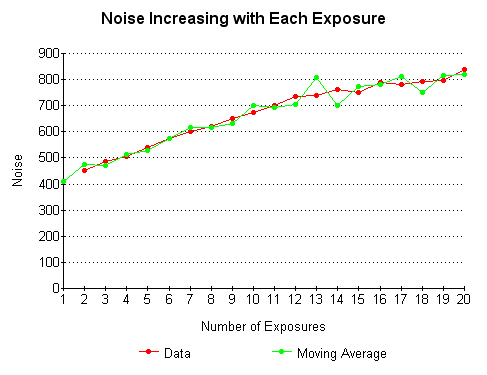Back to Astrophotography
CHIP HEATING EXPERIMENT (Part 2)
Go to Part 1 Part
3 Part 4 Part 5
This is part 2 of a 5 part investigation into camera noise. Parts 1,
2 and 3 sought to find out the best interval to put between sub-exposures in order to
minimise noise. The results show that the camera's CMOS chip gets gradually noisier
with each photo taken, and it makes little difference what gap you leave between
exposures.
Part 1 was a simple experiment to show that the camera gets noisier just
by being turned on. Also, if the camera is turned on, a big interval between shots
doesn't reduce noise. Turning off the camera for 10 minutes did reduce noise - but
what an inconvenience. Not practical. Part 2 investigates this further (see
the text under this graph).
Parts 4 and 5 show the effect of cooling the camera.

Part 2- Summary The camera gets noisier with each
exposure. A 10 minute pause doesn't help.
a) The noise definitely increases with each new exposure;
b) After 20 frames the noise is twice as bad as in the first frame;
c) When shooting deep sky if you take your dark frames either before or
after shooting the sequence of light frames then the dark frames will not
exactly match to any of the light frames even if air temperature is the
same.
d) After 20 frames the noise seems to begin leveling off to a limit; and
e) To get the noise back down around 400-500 units you must switch off the
camera and leave it idle for 30 mins or more! Obviously that would be highly
impractical.
EQUIPMENT
Canon EOS 350D (unmodified) In-camera Noise Reduction Off; ISO 1600.
A digital thermometer was used to measure air temperature
RAW DATA
| Sub |
Exposure
secs |
Interval
Seconds |
Temp
Deg C |
Noise**
(Pixel Value) |
Std Dev
(Pixels) |
Total Noise
(Pixel values) |
Reference
Elapse Time |
| 1 |
120 |
60 |
22.3 |
411 |
632 |
3.300e9 |
00:00 |
| 2 |
120 |
60 |
22.2 |
474 |
699 |
3.812e9 |
03:00 |
| 3 |
119 |
60 |
22.1 |
470 |
756 |
3.783e9 |
06:00 |
| 4 |
119 |
60 |
22.1 |
515 |
820 |
4.144e9 |
09:00 |
| 5 |
120 |
60 |
22.1 |
527 |
872 |
4.242e9 |
12:00 |
| 6 |
119 |
60 |
22.1 |
575 |
925 |
4.629e9 |
15:00 |
| 7 |
119 |
60 |
22.1 |
616 |
980 |
4.952e9 |
18:00 |
| 8 |
119 |
60 |
22.1 |
617 |
1013 |
4.967e9 |
21:00 |
| 9 |
120 |
60 |
22.1 |
631 |
1052 |
5.072e9 |
24:00 |
| 10 |
119 |
60 |
22.1 |
702 |
1099 |
5.644e9 |
27:00 |
| 11 |
119 |
60 |
22.1 |
692 |
1125 |
5.565e9 |
30:00 |
| 12 |
119 |
60 |
22.1 |
706 |
1157 |
5.679e9 |
33:00 |
| 13 |
119 |
60 |
22.1 |
808 |
1203 |
6.498e9 |
36:00 |
| 14 |
119 |
60 |
22.1 |
701 |
1201 |
5.635e9 |
39:00 |
| 15 |
118 |
60 |
22.1 |
772 |
1229 |
6.209e9 |
42:00 |
| 16 |
119 |
60 |
22.0 |
780 |
1260 |
6.274e9 |
45:00 |
| 17 |
120 |
60 |
22.0 |
811 |
1285 |
6.527e9 |
48:00 |
| 18 |
125 |
60 |
22.1 |
752 |
1336 |
6.053e9 |
51:00 |
| 19 |
120 |
60 |
22.1 |
817 |
1325 |
6.572e9 |
54:00 |
| 20 |
120 |
60 |
22.1 |
819 |
1338 |
6.585e9 |
57:00 |
| 21 |
119 |
10 |
22.0 |
883 |
1381 |
7.100e9 |
59:10 |
| 22 |
120 |
10 |
21.9 |
917 |
1422 |
7.377e9 |
1:01:20 |
| 23 |
120 |
10 |
21.9 |
906 |
1455 |
7.287e9 |
1:03:30 |
| 24 |
119 |
10 |
21.9 |
836 |
1466 |
6.765e9 |
1:05:40 |
| 25 |
119 |
10 |
21.9 |
876 |
1492 |
7.047e9 |
1:07:50 |
| 26 |
119 |
10 |
21.9 |
962 |
1545 |
7.733e9 |
1:10:00 |
| SWITCH OFF AND LEAVE CAMERA IDLE FOR 30
MINUTES |
| 27xxx |
|
30minutes |
22.0 |
509 |
829 |
4.098e9 |
1:42:00 |
| 28xxx |
|
30secs |
22.0 |
543 |
923 |
4.367e9 |
1:44:30 |
** These are dark frames so the average value of Red pixels is used here
in the table as a measure of noise.
xxx Image 27&28 were taken after switching the camera off for 30
minutes.
Go to Part 1 Part 3 Part 4
Part 5
Back to Astrophotography
|

